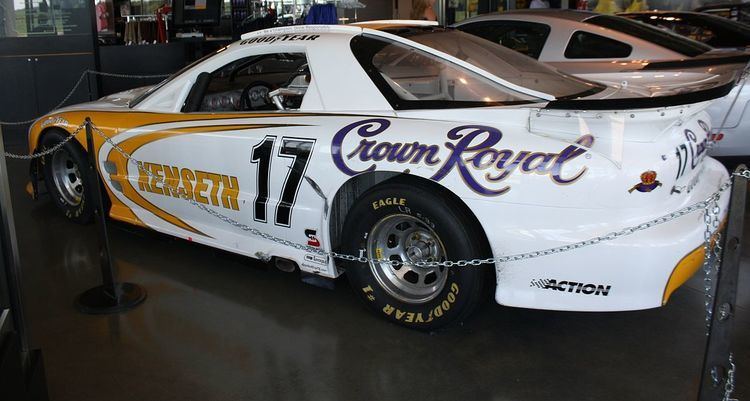Inaugural season 1974 Drivers 12 | Folded 2006 Constructors Pontiac | |
 | ||
International Race of Champions (IROC) was a North American auto racing competition, promoted as an equivalent of an American All-Star Game or The Masters. Despite its name, the IROC was primarily associated with North American oval-racing culture.
Contents
Drivers raced identically-prepared stock cars set up by a single team of mechanics in an effort to make the race purely a test of driver ability. It was run with a small field of invited drivers (6–12). It was created and developed in 1972 by David Lockton, the developer of the Ontario Motor Speedway, launched in 1973, with Mark Donohue being the first driver to win the championship in 1974. The cars used that year were Porsche Carrera RSRs. Donohue's win in the fourth and last race of that season was his last win, as he died in a Formula One crash at the Österreichring in practice for the 1975 Austrian Grand Prix. The series was not run in 1981, 1982, or 1983.
In 2007, IROC could not find a sponsor and postponed the first two races at Daytona and Texas. IROC went on hiatus in 2007 hoping to return with a sponsor in 2008. In March 2008, IROC auctioned off its tools, equipment, cars, and memorabilia, and went out of business.
Drivers
The drivers invited were from a broad range of racing disciplines: Indy cars, NASCAR, sports car racing, and on occasion, WoO, and drag racing. Criteria for invitation was very loose, but typically consisted of recent season champions of the respective series, and individual winners of big events (Indy, Daytona, etc.)
Due to its fundamental stock car formula, and the majority of racing being contested on ovals, the series was often dominated by NASCAR participants (which was the major criticism of the series). Also, in the small field of about a dozen cars, the share of NASCAR invitees grew over time; from just three drivers in the first season to seven in the final season. The last non-NASCAR based champion of the series was Al Unser, Jr. in 1988. Although open wheel drivers had numerous successes, as of 2005, drivers from road racing series had only won two races in the history of IROC. In some years, no sports car drivers were even invited.
Car identification
Through 2003, IROC was also known for its rainbow of car colors being easily recognized from all other closed wheel racing series. Car numbers were utilized for scoring purposes, but were not the primary means of identification. Instead, the drivers' surname would appear on the door of the car. Exceptions were made when Mario and Michael Andretti raced in the same events. In those cases, their first name was used. The numbers would change from race to race, with the number 1 would be given to the driver starting first, and so on. The colors would correspond to the numbers. Before the races, drivers were assigned via blind drawing, and was how the starting grid for the first race was determined. The finishing order of the race would be inverted for the second race's starting grid, while the reverse of the points standings determined races three and four's grids. Numbers were assigned by the starting position. After the first race, the numbers would be assigned based on points standings. This would make it very confusing for fans, as one week their favorite driver could be driving the blue #1 car, and the next week he could be in the #5 orange car.
In 2004, the Diageo brand Crown Royal became the series' title sponsor, replacing True Value, and the procedure changed. The cars would be identically painted in white, with trim which could be changed to represent the driver's colors in his regular racing series. Further, a driver's number in IROC would be his regular number. Thus, Steve Kinser would use green trim with the #11, and Matt Kenseth's car featured yellow trim with a #17.
The only exception to the numbering scheme involves the number 3. Following the death of Dale Earnhardt in the 2001 Daytona 500, IROC retired the use of #3. Any driver with that regular number would use #03 instead. Hélio Castroneves raced with #03, but the car kept red trim, in reflection of his IRL car being red.
If there was a numbering conflict, another number would be substituted. In most cases, for one-digit numbers, a zero would be added in front. Otherwise a historically notable number would be run. (Penske drivers, for one instance, could use #66, owing to Mark Donohue.)
Road racing
From 1992–2005, the IROC season was exclusively run on ovals. In 2006, road courses were reintroduced to the IROC series with the cars competing on the road course at Daytona International Speedway. Also, in 2006, two drivers shared one car in an IROC first. Grand American Road Racing drivers Max Angelelli and Wayne Taylor each drove two races in 2006, trying to win the IROC title as a team, reflecting sportscar racing as a two-man team. However, in 2007, that may not have been used, as 2006 Grand American Road Racing champion Jörg Bergmeister was a solo champion. Bergmeister had to split driving duties with various drivers because his regular co-driver was forced to sit out three races because they were raced with the Indy Racing League; Colin Braun, who was 17, could not race in those three races under MSA rulings.
